| Pages:
1
..
77
78
79
80
81
..
103 |
RogueRose
International Hazard
    
Posts: 1585
Registered: 16-6-2014
Member Is Offline
|
|
Recrystalizing of CuSO4 - odd results when adding Na2CO3 - brown liquid
I wanted to recrystalize some CuSO4 I had. After about 60% or so of the crystals had formed (by weight of original crystals), looked at the remaining
liquid and it had a slight green tint as well as a black tinge to it. The process took place at room temp over 5-6 months.
I thought I would try to add some Na2CO3 to it to make copper carbonate but the result was very different than doing the same with a more pure CuSO4
sample I added carbonate to.
The pure sample ended up with a nice green precipitate with a light blue liquid above the settled precipitate.
The remaining liquid from the recrystalization resulted in a brown precipitate that turned almost gelatenous. The same Na2CO3 was used for both
samples.
Now it is very possible that the recrystalization had some FeSO4 (1-3% possibly) mixed with the CuSO4 (which is why I wanted to purify). Would the
CuSO4 crystalize leaving the FeSO4 in solution if there was this much of a difference in concentration? It seems that the brown precipitate may be
iron carbonate though it seems that there has to be a lot of iron carbonate in the solution for it to turn so brown.
From pure CuSO4
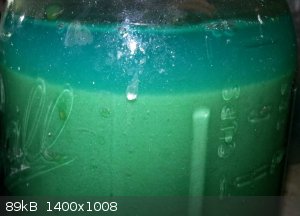 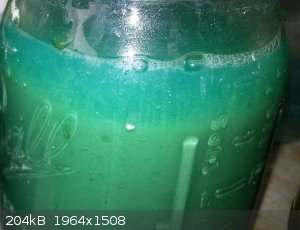
Remaining solution from recrystalization
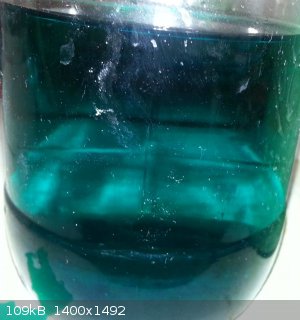
Above solution with Na2CO3 added
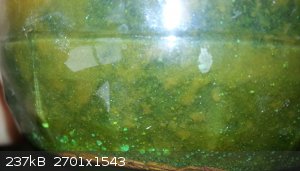 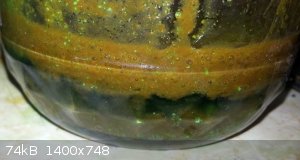 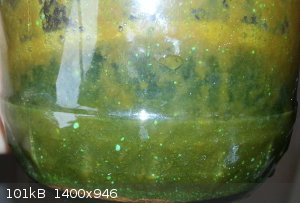
|
|
|
DraconicAcid
International Hazard
    
Posts: 4278
Registered: 1-2-2013
Location: The tiniest college campus ever....
Member Is Offline
Mood: Semi-victorious.
|
|
I don't think you'll form iron carbonate- as soon as the solution becomes slightly basic, iron(II) ions will react with oxygen to give iron(III)
hydroxides.
Please remember: "Filtrate" is not a verb.
Write up your lab reports the way your instructor wants them, not the way your ex-instructor wants them.
|
|
|
JJay
International Hazard
    
Posts: 3440
Registered: 15-10-2015
Member Is Offline
|
|
Root Beer Flavoring
When I was very young I remember making root beer with sassafras oil. Obviously, no one is doing that any more. Does anyone know offhand what
manufacturers use as root beer flavoring these days?
|
|
|
wg48
National Hazard
   
Posts: 821
Registered: 21-11-2015
Member Is Offline
Mood: No Mood
|
|
Aldi (a European discount supermarket) has sold what it said on bottle was an American root beer. The beer was flavoured with what to me is germolene
(an antiseptic ointment from my childhood) which contained methyl salicylate. Its weird that a beer would smell like that.
|
|
|
Crowfjord
Hazard to Others
  
Posts: 390
Registered: 20-1-2013
Location: Pacific Northwest
Member Is Offline
Mood: Ever so slowly crystallizing...
|
|
The main root beer flavoring these days is methyl salicylate/oil of wintergreen. The original root beer recipe used equal amounts of sassafras and
wintergreen, along with other roots and herbs like sarsaparilla, licorice, dandelion root, cherry bark, birch bark, and some others. Hansen's uses
sassafras in their root beer, but it's hard to taste it over the wintergreen and vanilla.
|
|
|
S.C. Wack
bibliomaster
    
Posts: 2419
Registered: 7-5-2004
Location: Cornworld, Central USA
Member Is Offline
Mood: Enhanced
|
|
Shirley there is more than (if any) methyl salicylate in A&W. Order sassafras oil and you'll get methyl salicylate, perhaps with eugenol.
Arctander mentioned other esters and stuff like p-dimethoxybenzene WTF.
Who remembers typical root beer with the safrole, over 50 years ago? Because the frosty mugs of A&W of 40 years ago (and A&W's food) could
hardly have been better. AFAIK. Gee if only I had a drop of safrole I could just add it to root beer...
[Edited on 19-10-2017 by S.C. Wack]
|
|
|
The Volatile Chemist
International Hazard
    
Posts: 1981
Registered: 22-3-2014
Location: 'Stil' in the lab...
Member Is Offline
Mood: Copious
|
|
Hmm. I've seen DIY rootbeer kits, though it seems the flavoring they sell is likely mostly vanilla, etc. Is it just me that never knew Root beer had
oil of wintergreen/a minty taste? I've never heard/noticed this till you-all just brought it up...
You could always grow a sassafras tree. Also, Sioux City Sarsaparilla is a manufactured root beer that I used to have at the local bean-soup
historical festival (bean soup cooked in a giant iron cauldron over an open fire with lots of salt and meat is so good...), apparently they thought it
was close enough to the 'original' that it was worth selling at a historical festival. You could try that. I think Cracker Barrel sells then in their
stores, too, if you have one nearby.
[Edited on 10-20-2017 by The Volatile Chemist]
|
|
|
JJay
International Hazard
    
Posts: 3440
Registered: 15-10-2015
Member Is Offline
|
|
Birch bark contains methyl salicylate, so it seems reasonable to suppose that birch beer would contain it. But root beer has a distinctive smell and
taste that does not remind me of wintergreen at all... *shrug*
Sassafras bark and leaves have a fragrant odor but I don't think they contain any safrole. I think the powdered leaves are used in some Creole dishes.
(Oh and I'm well aware of how I could obtain some safrole if I wanted some but to me it just isn't worth it.)
|
|
|
Melgar
Anti-Spam Agent
    
Posts: 2004
Registered: 23-2-2010
Location: Connecticut
Member Is Offline
Mood: Estrified
|
|
Lots of people seemed to be interested in sassafras root bark on eBay, who were also interested in my listing for palladium chloride... I don't
imagine that stuff is artificial.
I think that on perhaps two occasions I may have inadvertently synthesized acetone peroxide. Once was when I noticed a precipitate when mixing used
piranha solution into a temporary waste container that almost certainly contained acetone. This is something I've been very careful to avoid since
then. The other time, I was attempting to dehydrate ethanol to ether, and added H2O2 to try to neutralize one of the more stubborn denaturing agents
that was giving me problems. I saw a white precipitate there too, but only briefly, and it dissolved. In both cases, I immediately added copper
sulfate, which decomposed the H2O2, and presumably would have decomposed any organic peroxides as well.
Neither of these was recent, but I just wanted to make sure for future reference, that transition metal salts would most likely be able to safely
neutralize suspected organic peroxides, correct? After all, I'm not actually sure there was anything there to neutralize in either case, but I do
want to make sure that if I DID have something dangerous, what I did earlier would actually work
[Edited on 10/20/17 by Melgar]
The first step in the process of learning something is admitting that you don't know it already.
I'm givin' the spam shields max power at full warp, but they just dinna have the power! We're gonna have to evacuate to new forum software!
|
|
|
ninhydric1
Hazard to Others
  
Posts: 345
Registered: 21-4-2017
Location: Western US
Member Is Offline
Mood: Bleached
|
|
Anyone have a good source of ninhydrin (I gave up trying to obtain the materials to synthesize it)? 1-5 grams will suffice, as long as the price isn't
above $20 USD.
The philosophy of one century is the common sense of the next.
|
|
|
AngelEyes
Hazard to Others
  
Posts: 187
Registered: 24-1-2003
Location: South of England
Member Is Offline
Mood: Better than it used to be.
|
|
Lithium Chloride
I have a solution of LiCl and I want to get the salt out without having to boil down a lot of solution. I tried adding methanol to the solution
(roughly the same volume as there was in the beaker already...approx 100ml) in the hopes it would crash some of the chloride out, but nothing.
Would another alcohol work instead?
Are there any common salts I could use to 'flush out' the LiCl?
This LiCl would be used for a coloured flame on Nov 5th so I would like to avoid anything that's going to interfere with that; ie sodium chloride.
Cheers
Angel.
\'Silk and satin, leather and lace...black panties with an Angel\'s face\'
|
|
|
The Volatile Chemist
International Hazard
    
Posts: 1981
Registered: 22-3-2014
Location: 'Stil' in the lab...
Member Is Offline
Mood: Copious
|
|
Quote: Originally posted by AngelEyes  | Lithium Chloride
I have a solution of LiCl and I want to get the salt out without having to boil down a lot of solution. I tried adding methanol to the solution
(roughly the same volume as there was in the beaker already...approx 100ml) in the hopes it would crash some of the chloride out, but nothing.
Would another alcohol work instead?
Are there any common salts I could use to 'flush out' the LiCl?
This LiCl would be used for a coloured flame on Nov 5th so I would like to avoid anything that's going to interfere with that; ie sodium chloride.
Cheers
Angel. |
Haha hmm... I'm looking for a method to precipitate out my lithium acetate myself, which has defied all of my own attempts. I can tell you that iPrOH
does not work. I will have to try EtOH or acetone sometime soon.
|
|
|
JJay
International Hazard
    
Posts: 3440
Registered: 15-10-2015
Member Is Offline
|
|
The attached document discusses procedures established by IUPAC in the 1960s for preparing sodium carbonate and sulfamic acid as primary standards.
Sodium carbonate is not exactly ideal because it emits carbon dioxide when neutralized, but sodium carbonate is widely accessible and easy to purify.
Sulfamic acid looks harder to purify but it is also accessible, and the purification specified here doesn't look too hard, but you rarely hear of
anyone using sulfamic acid in titrations. I guess.... Is there anything I'm likely to have sitting around the lab that is a better acidimetric primary
standard than sulfamic acid?
Attachment: 1803x0443.pdf (240kB)
This file has been downloaded 569 times
|
|
|
j_sum1
Administrator
       
Posts: 6219
Registered: 4-10-2014
Location: Unmoved
Member Is Offline
Mood: Organised
|
|
Thanks for that JJay. It is a good reference to have.
Short answer, I think, is "no". I doubt you will have access to better primary standards than sodium carbonate or sulfamic acid. And, I think your
assessment is correct -- that sulfamic acid is likely to be the better of the two.
|
|
|
AngelEyes
Hazard to Others
  
Posts: 187
Registered: 24-1-2003
Location: South of England
Member Is Offline
Mood: Better than it used to be.
|
|
Quote: Originally posted by The Volatile Chemist  | Quote: Originally posted by AngelEyes  | Lithium Chloride
I have a solution of LiCl and I want to get the salt out without having to boil down a lot of solution. I tried adding methanol to the solution
(roughly the same volume as there was in the beaker already...approx 100ml) in the hopes it would crash some of the chloride out, but nothing.
Would another alcohol work instead?
Are there any common salts I could use to 'flush out' the LiCl?
This LiCl would be used for a coloured flame on Nov 5th so I would like to avoid anything that's going to interfere with that; ie sodium chloride.
Cheers
Angel. |
Haha hmm... I'm looking for a method to precipitate out my lithium acetate myself, which has defied all of my own attempts. I can tell you that iPrOH
does not work. I will have to try EtOH or acetone sometime soon. |
I should have checked LiCl solubility...it's surprisingly soluble in water (69g/100ml @ 0c !!), but also fairly soluble in methanol. So my adding that
solvent was never likely to help.
I might give acetone a try; otherwise a long and slow evaporation will be the only option...
\'Silk and satin, leather and lace...black panties with an Angel\'s face\'
|
|
|
j_sum1
Administrator
       
Posts: 6219
Registered: 4-10-2014
Location: Unmoved
Member Is Offline
Mood: Organised
|
|
If you wish to avoid much of the evaporation process, you could always precipitate out Li2CO3. Then react that carbonate with some concentrated HCl
at a much smaller volume.
|
|
|
Sigmatropic
Hazard to Others
  
Posts: 307
Registered: 29-1-2017
Member Is Offline
Mood: No Mood
|
|
solutions of LiCl in water are hygroscopic, which makes alot of sense since the solid is deliquescent. Hence my futile attempt at preparing it failed.
None the less, I'm interested in a way of preparing it from lithium carbonate/hydroxide.
[Edited on 24-10-2017 by Sigmatropic]
|
|
|
DraconicAcid
International Hazard
    
Posts: 4278
Registered: 1-2-2013
Location: The tiniest college campus ever....
Member Is Offline
Mood: Semi-victorious.
|
|
I suspect that you're more likely to salt out the acetone than to precipitate the lithium chloride.
Please remember: "Filtrate" is not a verb.
Write up your lab reports the way your instructor wants them, not the way your ex-instructor wants them.
|
|
|
AngelEyes
Hazard to Others
  
Posts: 187
Registered: 24-1-2003
Location: South of England
Member Is Offline
Mood: Better than it used to be.
|
|
Quote: Originally posted by j_sum1  | | If you wish to avoid much of the evaporation process, you could always precipitate out Li2CO3. Then react that carbonate with some concentrated HCl
at a much smaller volume. |
I bought the Li as the carbonate because it was cheap. And I am reacting it with 32% HCl, which I think is about as strong as I can get OTC.
Problem is, that reaction will produce water (and CO2) as by products, so it instantly dilutes the freshly-formed LiCl.
I think I have no option but to evaporate on the kitchen hob (I have no hotplate) and think of something to explain it to the wife.
Cheers though
Angel.
\'Silk and satin, leather and lace...black panties with an Angel\'s face\'
|
|
|
VSEPR_VOID
National Hazard
   
Posts: 719
Registered: 1-9-2017
Member Is Offline
Mood: Fullerenes
|
|
Quote: Originally posted by Vargouille  |
It depends on the type of extinguisher that you use. CO2 extinguishers are highly compressed, so when they come out they're very cold, which can cause
frostbite. Also, if the person is on the ground, the CO2 can suffocate them. Some ABC dry chemical extinguishers are safe because their contents are
of negligible toxicity, but you should check their MSDS to make sure. Of course, the person will want to cover their face with their hands if you use
a dry chemical extinguisher on them, but other than that it's fairly safe.
http://www.homeofpoi.com/lessons_all/teach/Fire-Extinguisher... |
I would have their head on a silver tray if someone sprayed me with a chemical fire extinguisher well I was on fire. The chemical inside of the spray
MUST be removed from burns by scrubbing. This process of scrubbing raw burns is unimaginably painful and can last a large amount of time. Please use
the CO2 as a little frostbite is preferable to hours of painful scrubbing at the ER.
[Edited on 30-10-2017 by VSEPR_VOID]
Within cells interlinked
Within cells interlinked
Within cells interlinked
|
|
|
veerenyadav
Harmless

Posts: 30
Registered: 1-3-2014
Member Is Offline
Mood: No Mood
|
|
Solvent for metal carbides
Can anybody suggest a suitable solvent for metal carbides ( M3C, MC, etc) ?
|
|
|
veerenyadav
Harmless

Posts: 30
Registered: 1-3-2014
Member Is Offline
Mood: No Mood
|
|
Material with minimum difference in melting and boiling temperature
Which material has minimum difference in melting and boing temperature ?
|
|
|
gdflp
|
Threads Merged
1-11-2017 at 19:10 |
gdflp
|
Threads Merged
1-11-2017 at 19:11 |
SWIM
National Hazard
   
Posts: 970
Registered: 3-9-2017
Member Is Offline
|
|
The one that's at its triple point.
|
|
|
RogueRose
International Hazard
    
Posts: 1585
Registered: 16-6-2014
Member Is Offline
|
|
I tried setting up a chlorate cell and the problem I was worried about reared it's head. I've tried to choose anode and cathode which are accessible
to me so I chose stainless (cathode) and PbO2 (annode).
The PbO2 plates are from old SLA batteries which I oxidized in strong bleach. Since the plates are smallish, I stacked 3 vertically and used a copper
wire to connect them at their tabs. The wire is varnished transformer wire (new) and I removed the insulation at the point where it contacts the
plates, so there should be very little copper exposed in the solution.
The SS is non-magnetic and it is pretty shiny. I thought it was 304 or 316 but I think it is not. I do have another piece which is also non-magnetic
which I am trying now and I think it is more likely the 304 or 316.
I'm using 5v from a computer PSU but would like to try 12v but don't know if that will effect anything in the setup adversely.
I'm worried about the green/blue color in the solution and am wondering if this may be CuCl2 or a chrome or nickel salt that has come out of the
cathode - or is it the copper dissolving from the anode?
I'm planning on doing many re-crystalizations of the end product but IDK if any of these contaminates will dissolve in the chlorate solution. Should
I be worried about what is in the solution at this point? It ran for about 3 hours at maybe 15a (probably less).
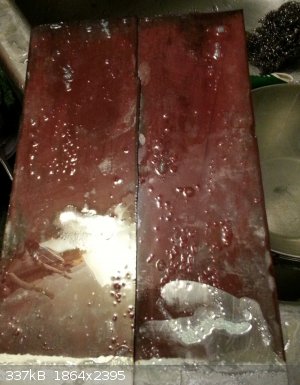 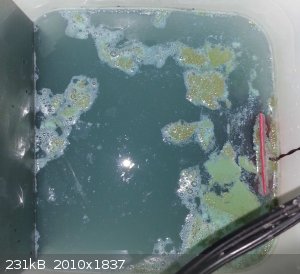 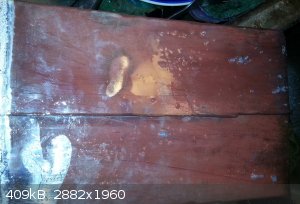
|
|
|
ninhydric1
Hazard to Others
  
Posts: 345
Registered: 21-4-2017
Location: Western US
Member Is Offline
Mood: Bleached
|
|
Would this be a viable alternative to silicone vacuum grease?:
https://www.lowes.com/pd/Danco-Grease/1092167
The manufacturer claims it to 95% silicone, resistant to temperatures from -40 to 204 degrees Celsius and an ambiguous "most harsh chemicals". Would
this be viable during distillations of relatively benign chemicals (alcohols, ketones, DCM, and other common solvents)? Would this also be viable for
the distillation of nitric acid among others?
The philosophy of one century is the common sense of the next.
|
|
|
| Pages:
1
..
77
78
79
80
81
..
103 |